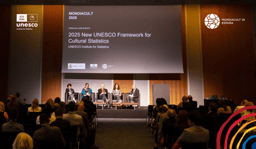Cultural capital financing: How museums can combine profit and social purpose
Published in Social Sciences and Economics

The inspiration for this World Economic Forum contribution, co-authored with @Dr. Giovanna Di Mauro, stems from our current deep-dive research on Abu Dhabi's growing ecosystem of upcoming and established museums, as well as from recent exchanges with friends and colleagues in Barcelona during MONDIACULT 2025, the IFACCA Member Convening and the 33rd ENCATC Congress.
As museums worldwide continue to compete for innovative forms of funding, a new framework – Cultural Capital Financing – could be conceived to help combine public funding with private investment, digital innovation and social entrepreneurship. This framework positions museums not just as repositories of artefacts , but also as impact enterprises capable of generating cultural, social, and economic value. The goal is to align cultural institutions with inclusive growth, environmental resilience and future-ready governance together with the 2030 Agenda for Sustainable Development.
Blended and impact-driven financing models
The Cultural Capital Financing approach promotes hybrid financial models blending cultural missions with sustainable economic strategies to ensure institutional longevity and resilience.
Core mechanisms include endowments, joint acquisitions, and auction guarantees, which reduce dependency on public funding. Complementary instruments such as Public-Private-Philanthropic Partnerships(4P) integrate institutional credibility, market innovation, and civic engagement, while impact investment funds ensure the ethical and sustainable management of cultural assets.
Additionally, Percent-for-Art schemes embed culture within broader development budgets, institutionalizing cultural investment as part of economic planning. Together, these blended models represent a shift toward value-driven cultural finance, aligning museums with global sustainability goals and enabling them to act as active contributors to creative economies and social innovation.
Suggested areas of focus
To consolidate this shift, the following areas should be the focus in the future:
- Cultural venture capital (CVC): Invest in creative technologies, AI applications and heritage innovation.
- Decentralized cultural finance (DeCuFi): Use blockchain to enable micro-investment and transparent funding for museums and cultural institutions.
- Circular cultural economies: Map and amplify the ripple effects of culture on tourism, well-being and environmental sustainability.
- AI ethics and cultural diversity: Promote inclusivity and representation in algorithmic curation and digital cultural platforms.
- Global cultural investment platform: Launch a platform connecting investors, policy-makers and creative institutions to foster cultural impact investment.
- Impact measurement framework: Adopt a model integrating financial, social and environmental metrics to assess cultural investment outcomes.
- Cultural finance literacy: Champion financial literacy in the culture sector through collaboration among policy-makers, academia and investors.
Conclusion
To sum up, museums should explore new forms of financing to generate diverse types of value across multiple sectors. Hybrid financing models enable museums to operate effectively as impact enterprises, enhancing their long-term sustainability. Moreover, revenue diversification allows museums not only to achieve economic returns but also to promote social inclusion, education, and environmental responsibility.
🌍 International translations and press mentions
🇮🇹 https://www.agenziacult.it/letture-lente/era-digitale/cultural-capital-financing-la-finanza-culturale-nellera-digitale/
🇬🇧🌐 https://www.weforum.org/stories/2025/10/museums-cultural-capital-financing-sustainability/
🇯🇵https://jp.weforum.org/stories/2025/10/museums-cultural-capital-financing-sustainability-ja/
🇨🇳 https://cn.weforum.org/stories/2025/11/museums-cultural-capital-financing-sustainability-cn/
🇨🇳 https://www.weiyangx.com/454233.html#:~:text=世界经济论坛发布的,更多可持续价值%E3%80%82






Please sign in or register for FREE
If you are a registered user on Research Communities by Springer Nature, please sign in